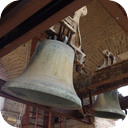(short preview of full seamless looping track)
Bells
This product is not available in the selected currency.
In Stock
Backordered
Out of Stock
Description
The sun drenched hills sparkle like a green avalanche rushing down into the valley, bringing a breeze of fresh fragrance and birdsong, burying the people under a blanket of summer. As the bells ring out, you wander through the ancient stone streets, staring into windows and down alleyways, hoping to find some long lost material treasure or perhaps your next great love. European Christian church bells typically have the form of a cup-shaped cast metal resonator with a flared thickened rim, and a pivoted metal striker or clapper hanging from its center inside. It is usually mounted high in a bell tower on top of the church, so it can be heard by the surrounding community. The bell is suspended at its apex from a horizontal axle, so it can swing from side to side. A rope is tied to a pulley or lever on the axle, and hangs down to ground level. To ring the bell, the bell-ringer pulls on the rope, swinging the bell. The motion causes the clapper to hit the inside rim of the bell as it swings, making the sound. Alternatively, the bell may be suspended from a stationary support, and the bell rung by pulling a rope attached to the clapper to one side. Church bells became common in Europe in the early Middle Ages. They were first common in northern Europe, reflecting Celtic influence, especially that of Irish missionaries. Before the use of church bells, Greek monasteries would ring a flat metal plate (see semantron) to announce services. The signa and companae used to announce services before Irish influence may have been flat plates like the semantron rather than bells. The oldest surviving circle of bells in Great Britain is housed in St Lawrence Church, Ipswich. The oldest church bell in the world is one donated by Despot Alexius Slav to the metropolitan church in Melnik, Bulgaria, and dated to 1211-1216. It is now kept at the National Museum of History in Sofia.
Opps
Sorry, it looks like some products are not available in selected quantity.



